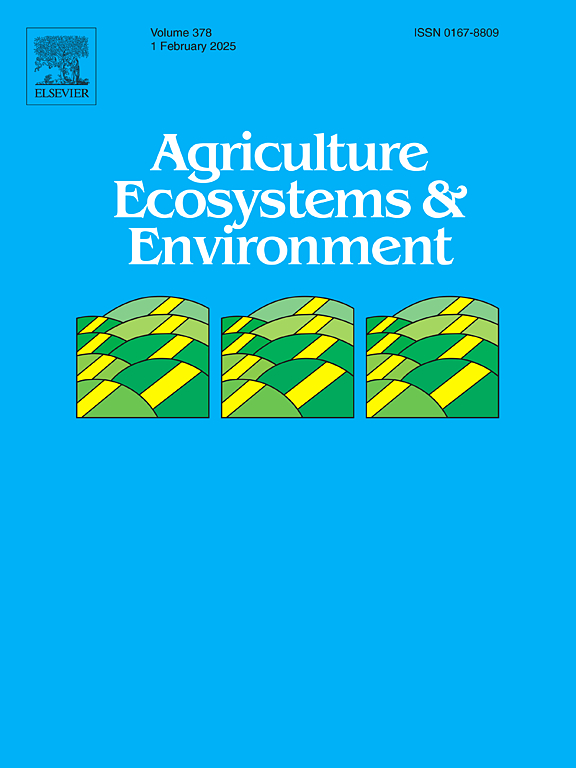拉姆萨尔湿地附近水鸟群落对季节和环境因素的反应
IF 6.4
1区 农林科学
Q1 AGRICULTURE, MULTIDISCIPLINARY
引用次数: 0
摘要
世界范围内的天然湿地已经丧失或退化,对水鸟种群产生了负面影响。然而,许多物种已经利用了互补栖息地的创造,如稻田,一种常见且广泛存在的人工湿地。尽管稻田作为水鸟的补充栖息地具有重要意义,但很少有研究探讨水鸟如何跨季节利用这些湿地以及它们如何应对不同的当地环境因素。研究了2023 ~ 2024年,安徽省盛金湖国家级自然保护区附近稻田水鸟群落在水稻生育期和收获后的多样性,分析了环境因素对水鸟群落多样性指标的影响。在稻田内共观测到33种水鸟15085只,在大多数时期,稻田内水鸟多样性指数普遍高于保护区外水鸟。水鸟密度在苗期和越冬前达到高峰。物种丰富度、Shannon-Wiener多样性指数以及鸭和滨鸟密度在苗期最高,而海鸥密度在开花期最高。相反,鹅密度在越冬前期最高。面积较大、形状不规则、水深较深、排水密度较高、邻近较大稻田和胜金湖的稻田支持较高的水鸟密度和物种丰富度。主要道路和定居点的人为干扰对水鸟产生了负面影响。然而,在某些时期,水鸟被可能暴露稻田食物资源的人类活动所吸引。这些发现对这些人工湿地的水鸟保护具有重要意义,因为它们在全球湿地丧失和退化的背景下具有重要作用。本文章由计算机程序翻译,如有差异,请以英文原文为准。
How waterbird communities respond to seasonal and environmental factors in rice fields adjacent to a Ramsar wetland
Natural wetlands have been lost or degraded worldwide, negatively impacting waterbird populations. However, many species have capitalised on the creation of complementary habitats such as rice fields, a common and widespread type of artificial wetland. Despite the significance of rice fields as supplementary habitats for waterbirds, few studies have explored how waterbirds use these wetlands across seasons and how they respond to different local environmental factors. We surveyed waterbird communities in rice fields near Anhui Shengjin Lake National Nature Reserve, a Ramsar site, during the rice growing periods and the post-harvest periods from 2023 to 2024, to analyse the impact of environmental factors on the metrics of community diversity. We observed 15,085 waterbirds of 33 species in the rice fields, with diversity indices that were generally higher in rice fields inside the reserve than those outside the reserve in most periods. Waterbird densities peaked during the seedling and pre-wintering periods. Species richness, the Shannon-Wiener diversity index, and the densities of ducks and shorebirds were highest during the seedling period, while gull densities peaked in the flowering period. In contrast, goose densities were highest during the pre-wintering period. Rice fields with larger areas, irregular shapes, deeper water, higher drain density, and closer proximity to larger adjacent rice fields and Shengjin Lake supported higher waterbird densities and species richness. Human disturbances from main roads and settlements negatively affected waterbirds. However, during certain periods, waterbirds were attracted by human activities that may expose food resources in rice fields. These findings provide important implications for waterbird conservation in these artificial wetlands, which are of global significance given their important role in the context of worldwide wetland loss and degradations.
求助全文
通过发布文献求助,成功后即可免费获取论文全文。
去求助
来源期刊

Agriculture, Ecosystems & Environment
环境科学-环境科学
CiteScore
11.70
自引率
9.10%
发文量
392
审稿时长
26 days
期刊介绍:
Agriculture, Ecosystems and Environment publishes scientific articles dealing with the interface between agroecosystems and the natural environment, specifically how agriculture influences the environment and how changes in that environment impact agroecosystems. Preference is given to papers from experimental and observational research at the field, system or landscape level, from studies that enhance our understanding of processes using data-based biophysical modelling, and papers that bridge scientific disciplines and integrate knowledge. All papers should be placed in an international or wide comparative context.
 求助内容:
求助内容: 应助结果提醒方式:
应助结果提醒方式:


